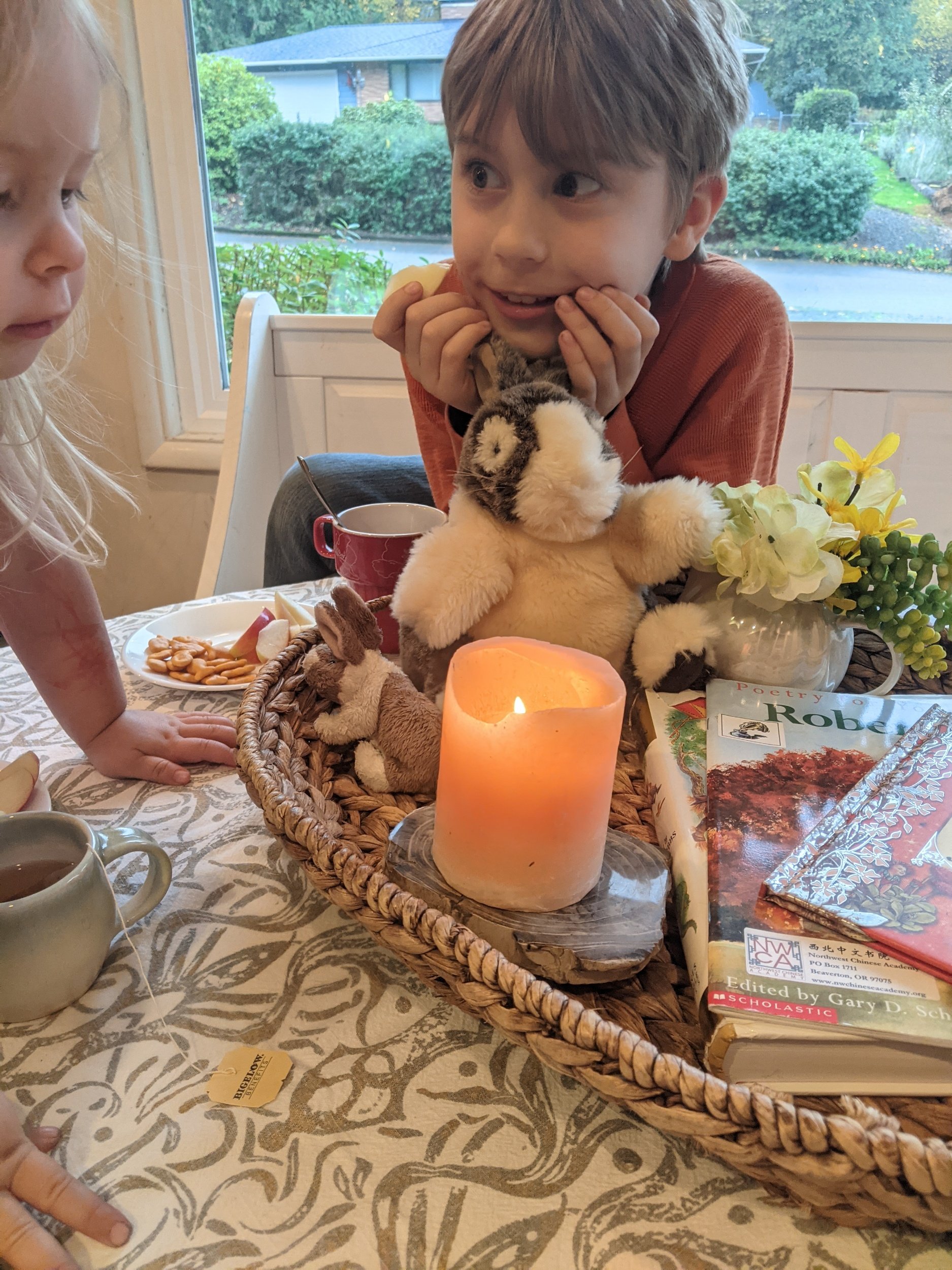10 Ways to Manage Toddlers and Babies with Family-Style Homeschooling
Let's be real, if you are homeschooling big kids and also have children under three at home, it's definitely a challenging chapter. With little babies, IF you aren't having huge sleep struggles, you “might” be able to manage some tasks with the big kid while the little one is sleeping…in a baby carrier, attached to you, and possibly while mom is nursing, so that you are multi-tasking to the max. (I don't totally recommend this, sanity-wise, just saying that it’s POSSIBLE.) But when bored toddlers dive bomb you every time you sit down to read, or run off just when you get big kid down for some focused table time…oh my.
Here are my top tips and tricks for managing the littlest kids while homeschooling the big kids:
1) Audiobooks and more
Think beyond the paperback. Audiobooks are such a lifesaver for reading time because your arms are free. I find most of them on Libby or Scribd. We also like podcasts a lot. Some of our favorites are BrainsOn, Eat Your Spanish, Forever Ago, Story Pirates, Finn Caspian, Greeking Out, Short & Curly, Smash Boom Best, and What If World. Sometimes, I find read alouds on YouTube though I know there can be legal permissions issues with these at times so I can't endorse most of them. Kid Time Storytime is engaging and good for picture books.
Teatime play for my toddler during reading time
2) Set the Stage for Play
Set up the little one with a favorite activity, such as sensory bins, playdough, coloring, teatime with baby dolls, duplos, etc. The best choices are things that don't come out all the time, because they tend to engage in longer play if it's something “special.” My daughter loves painting with watercolors. Sometimes, the big kid wants to do what the little one is doing. If that happens, I usually do some more reading out loud. Or ask them to finish what they are doing first.
Poetry teatime is popular in our homeschool
3) Snack time = School time
Put the little one in the high chair, make something to munch on (low mess helps), and bring writing, math, reading, whatever over to do with your big kid. My son really enjoys snacking while he works too.
Kids can help with activity prep too
4) Let them “Do School” too
Kids can help prep for an activity, by clearing the counter, gather materials, stir, prep, tape, etc. Many children are eager to feel like they are doing it by themselves. Just feel out the number of steps they seem to be able to manage for the task, and stick to that so they don't lose interest. My method is to pull out the activity guide and read it out loud (often with toddler on hip). “Oh! This one looks fun, what materials do we need? Looks like it says sugar, cups, etc. Do you know where the sugar is? Great, what else does it say… Hmm we don't have enough glue, huh, I wonder if we could read ahead and see if tape would work…. now let's find…etc.” Talk it through step-by-step and ask a lot of questions about what happens next in the activity. This helps a lot and you can teach them important executive function skills about how to break down and initiate tasks, get organized, plan, and problem solve.
6) Redefine School
We do a lot of active schooling in this playgym space (a converted garage)
Homeschooling doesn't have to happen seated at a table. Active hands-on schooling can be a much better fit when a busy toddler is in tow. Dig in the dirt and explore the science of soil. Make slime and learn about the scientific method. Toss a ball around while practicing math facts. Discuss a recent reading in the car on the way to someplace fun.
7) Take School Outdoors
Explore a natural area near you and learn about the flora and fauna of your region. If you have a safe backyard playspace, or a nearby playground for little ones, let your toddler play while you give your big kid some slightly more focused attention. Make nature your classroom and turn rocks, sticks, pinecones and into your math manipulatives. Write artistic poetry with chalk on sidewalks. Spending more time outdoors might just bring some newfound peace into your homeschool days.
Nature study is a great family learning experience
8) Bring in Help
You don't need to be your children’s sole teacher and there are a lot of different ways to enlist help. First, if you have a partner, you are likely already experienced at splitting up tasks and that's a great person to involve. But a grandparent, an aunt, a babysitter, or another homeschooling friend are all great potentials for homeschool helpers. You can split up subject areas or simply activities. Maybe one of you is math-inclined and wants to guide that topic. Or maybe your helper can play learning games with the big kids, or work on an art or science kit, while you do something with the little one. Or maybe your helper spends special time playing or reading to your littlest ones, while you work with the big ones. Having other people teach your kids can be valuable tool for many reasons, just one of which is that it can help with juggling kids of multiple ages. Cooperative classes, community center activities, and online classes theiugt services like outschool are other great tools to engage your big kids with activities that the little ones can't do yet.
9) Learning is Part of Life
With kids of multiple ages, you need to be smart about your time. One way to do that is to teach through the practical activities of daily life. Everytime you use math, it can be an opportunity to learn. My son enjoys baking with me and I make large batches of muffins and things like that for snacks and breakfast. My toddler stands on her stepstool next to us and makes a mess stirring flour while we double recipes and add up the number of cups total that a recipe will make. We've also been doing work on our landscaping and have had a lot of fun measuring the land with a rolling ruler, assessing the height of slopes and so on.
We love cozy evening reading time
10) Nights, weekends, anytime that works
On the topic of having help, this can be easier if you let go of “schooling” at a certain time of day. Also, if you aren't trying to focus for long chunks if the day, its going to be easier on everyone. Find the time of day that works best for you. Short 20 min bursts are all you need for younger kids. You might find with older children that ten minutes of directed attention may start to lead them into a longer chunk of self-directed learning.
BONUS: Let go of Fear, Embrace Joy
A fun toddler-safe slime recipe from our Slime Science guide
Reduce your expectations. This challenging chapter won’t last forever. Relax your agenda and don’t keep pushing when it’s too stressful. Your stress won’t do any favors for your children’s learning process. There are no emergencies in education. When you homeschool you are fortunate to be able to let go of any set timeline of “achievement.” When we homeschool from a place of fear - fear over whether we are doing enough, fear over whether our kids will learn what they need to learn, we suck the joy out of learning. If we want to raise life-long learners, we want children to follow their interests and enjoy the process of learning. Prioritize connection and fun in your homeschool.
I hope these tips help you with family homeschooling. If you need more guidance, be sure to check out the Northstar Educational Explorations store. Our unit study guides are designed to help families homeschool a wide range of ages together. I should know - the activities are definitely kid-approved - road-tested with my own toddler too! Dirt: Dig In delves into the wonders of soil - a great place to start with family homeschooling.









